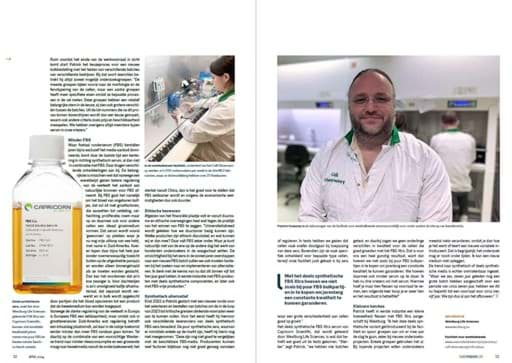
How to end transfection difficulties when you can use mRNA
mRNA transfection: reconsider your expression studies.
In summary?
- DNA transfection versus mRNA transfection
- Why is mRNA not the standard method?
- Advantages of mRNA transfection
- The solution to end transfection difficulties
Why do transfection?
DNA transfection versus mRNA transfection
With all the work waiting for you, choosing the easiest method to get answers to normal cellular processes, disease molecular mechanisms, and gene therapeutic effects (1) is understandable. The most well-known and used technique is DNA transfection (hyperlink naar andere blog) to insert a (modified) gene of interest in your cells. A plasmid DNA is constructed and will form a complex with the transfection reagent to attach to the cell membrane. The cell takes up this reagent-DNA complex to release the DNA into the cytoplasm through endocytosis. Now, we are only at the start of the process. The DNA must enter the nucleus before it can be transcribed, via pre-mRNA, into mRNA. DNA entrance into the nucleus is crucial since mRNA is needed to translate the gene into a protein or perform gene editing studies—unfortunately, the most challenging step to achieve with complex cells.This latter issue can drive you insane. You started with the notion that it would be easy, but now, after each try, it is not working. Even an expensive transfection reagent doesn't do the trick.
Switching to laborious and often strictly regulated viral transfection is usually not an option. And not favorable for pregnant researchers.
The mRNA transfection process is straightforward. mRNA is directly delivered and expressed in the cytoplasm and thus does not require crossing the nuclear membrane. After delivery, the cell machinery translates mRNA into a protein in the cytoplasm.

mRNA disadvantages
Why is mRNA not the standard method?
Technicians struggle with the instability of (m)RNA outside the cell, as it misses the stability a double helix offers. RNA contains ribose sugar, making it more reactive than DNA and unstable in alkaline conditions, which may occur in your experimental workflow. RNA's larger helical grooves mean it is more easily subject to attack by enzymes and more resistant to UV light damage than DNA. Usually, the laboratory fridge is full of existing plasmid constructs or plasmids ready to use to insert a new template. It is harder to change to mRNA vectors. But why stick to DNA plasmids if it doesn't give you the desired results? You can switch to a method requiring working securely.mRNA advantages
Advantages of mRNA transfection
mRNA transfection has some advantages over DNA transfection, which are especially helpful when working with complex cell types in gene editing research:- mRNA tends to transfect more efficiently, reaching higher efficiencies (>80%) for hard-to-transfect cell types.
- Directly after transfection, the mRNA transcription as soon as it enters the cytoplasm results in more rapid protein expression. You are not at the mercy of the unpredictable course of DNA entering the nucleus and the uncertain amount of transcribed mRNA.
- Protein expression is easily adjustable by changing mRNA concentrations or transfection repetition.
- mRNA transfection does not require nucleus entry and is ideal for non-dividing cells.
- There is no risk of insertional mutagenesis, hence no genome modification of the transfected cell when performing transient transfections.
This gene expression method is an ideal solution for the transfection of stem cells, neurons, lymphoma, and many more hard-to-transfect cell types. The transient nature of mRNA transfection is desirable for many applications, including cellular reprogramming, genome editing (CRISPR/Cas9), and vaccines.

Our solutions
The solution to end transfection difficulties
The jetMESSENGER mRNA transfection reagent has proven benefits over other mRNA transfection reagents. With the unmatched transfection efficiency, high efficiency on a wide variety of difficult-to-transfect cells, and extreme gentleness on the cells, the jetMESSENGER is superior to its peers. As it is easy to scale up and down and 2-fold lower in costs compared to Lipofectamine™ MessengerMAX™ this mRNA reagent is ideal for both general laboratory work and biotechnology research.
jetMESSENGER mRNA Transfection Reagent - 0.1 ml
jetMESSENGER mRNA Transfection Reagent - 0.75 ml
FectoCHO CD Expression Medium, 6x1L
FectoCHO Expression System, Kit (S)
FectoPRO 1 ml reagent + 1 ml Booster
Lorem
Success stories
Lorem ipsum dolor sit amet, consectetur adipiscing elit. Nunc nec nibh sed sem mattis malesuada. Aenean lobortis vulputate massa sit amet pellentesque. Duis quam sapien, fermentum nec porta vitae, laoreet sed nunc. Suspendisse scelerisque arcu eu molestie mattis. Ut ornare sit amet ante viverra luctus. Integer eleifend sollicitudin purus, eget suscipit massa blandit in. Fusce neque tortor, laoreet vel justo vitae, mollis dignissim ex. Morbi quis ultrices nulla, eget accumsan augue. Sed ut lacus vitae velit tincidunt mollis ac eu sapien. Phasellus ullamcorper est quis massa pharetra, sit amet molestie mi molestie. Etiam laoreet, leo ac tincidunt commodo, elit eros eleifend nisi, sit amet convallis nulla libero id lacus. Vivamus facilisis gravida varius. Praesent efficitur venenatis augue et efficitur.
Our news

Get you free tickets. Let's meet at the WoTS
Will you be there from September 24 to 27 at the World of Industry, Technology & Science 2024?

Trade-in summer promotion
20% discount on a new thermocycler, cell counter or nanophotometer

Leiden Cell Observatory switches to partly synthetic seru...
April 2024 - This has several advantages. Lab manager Patrick Voskamp shares his experience in this article





